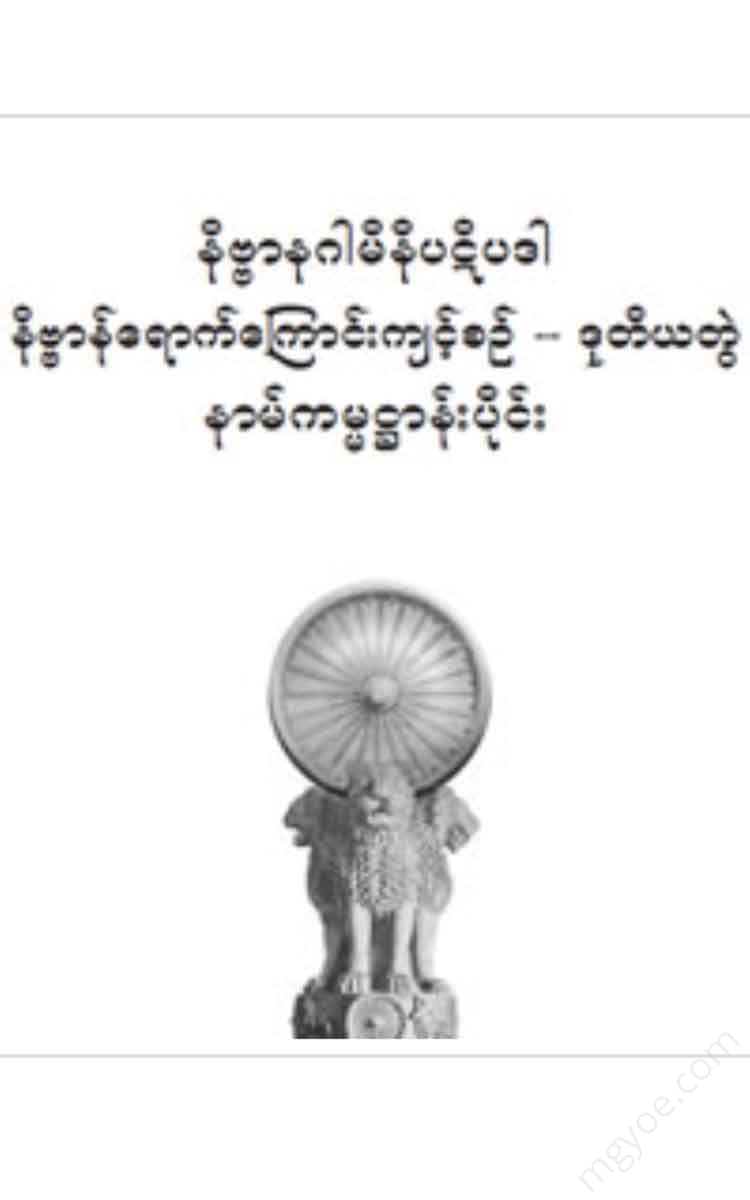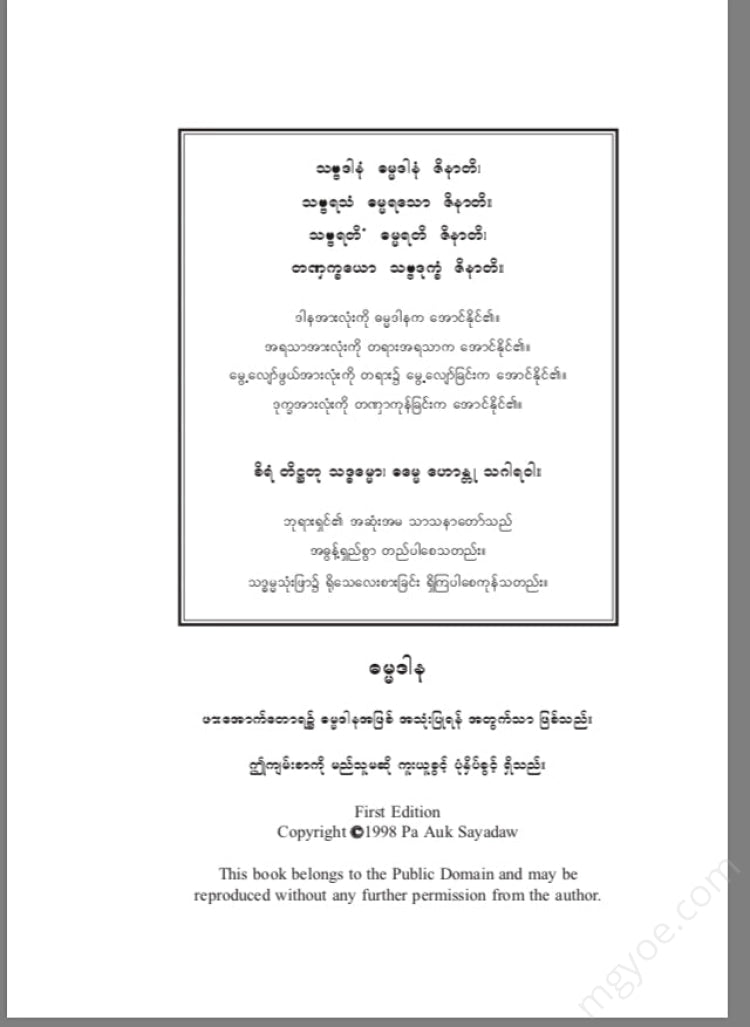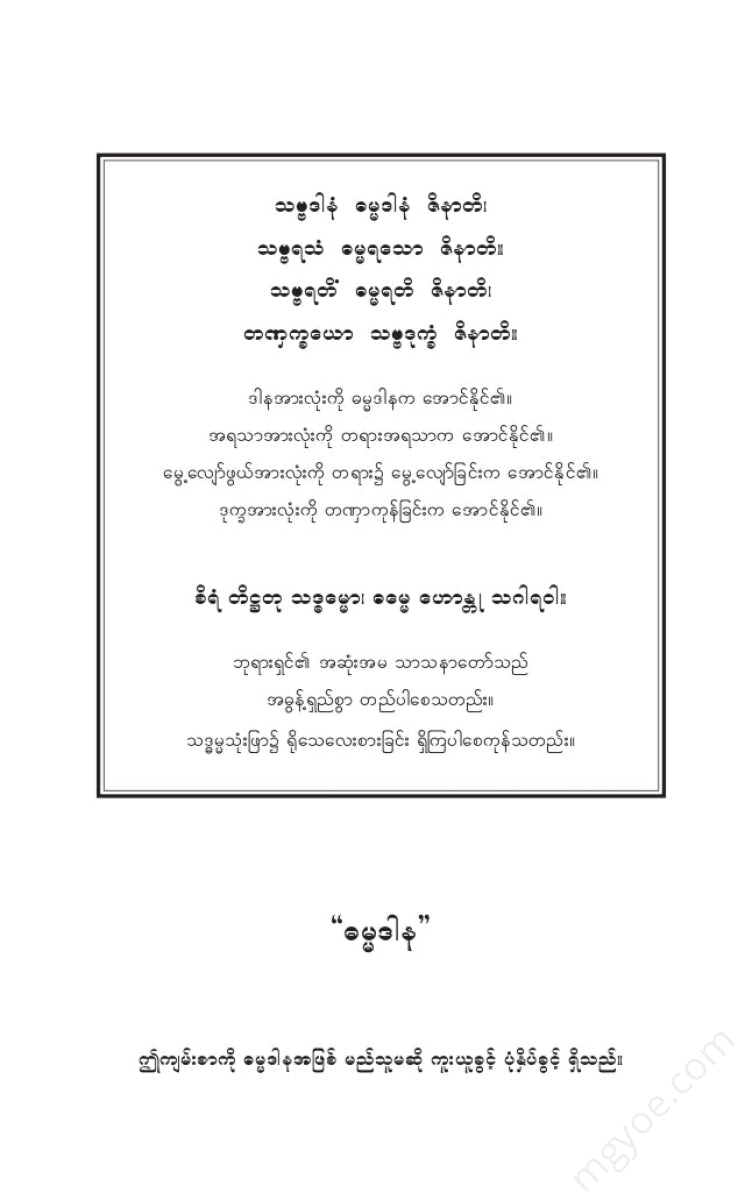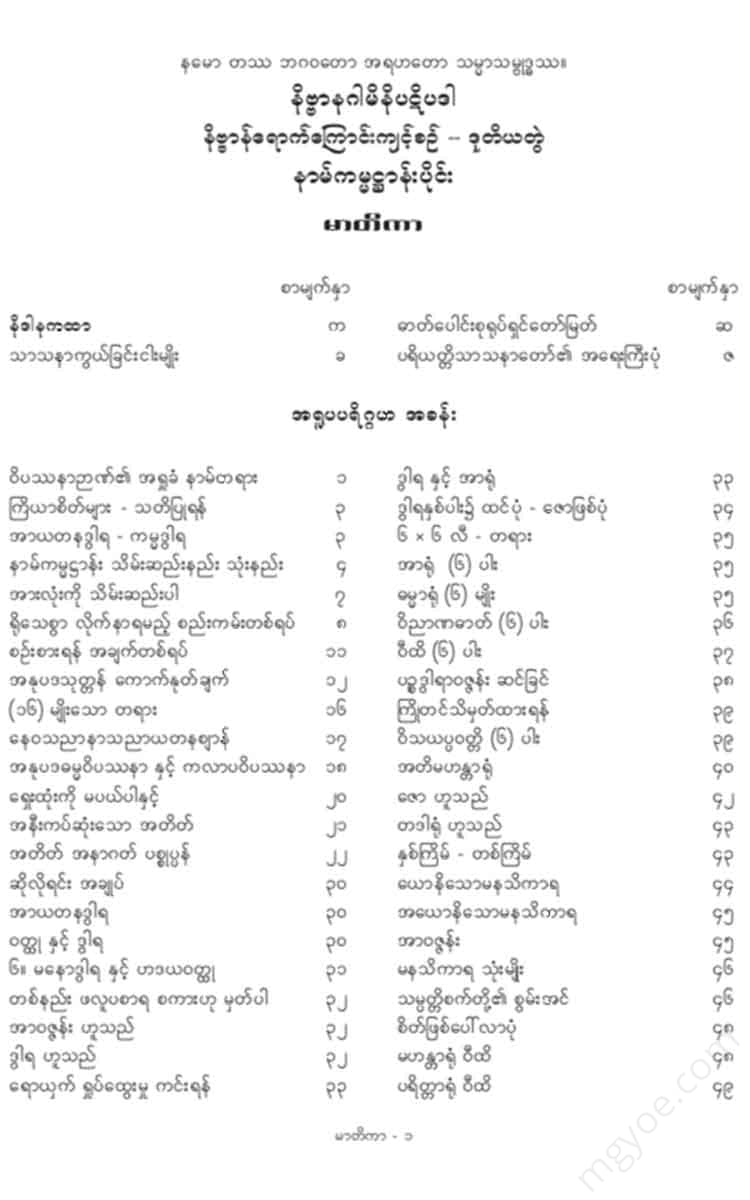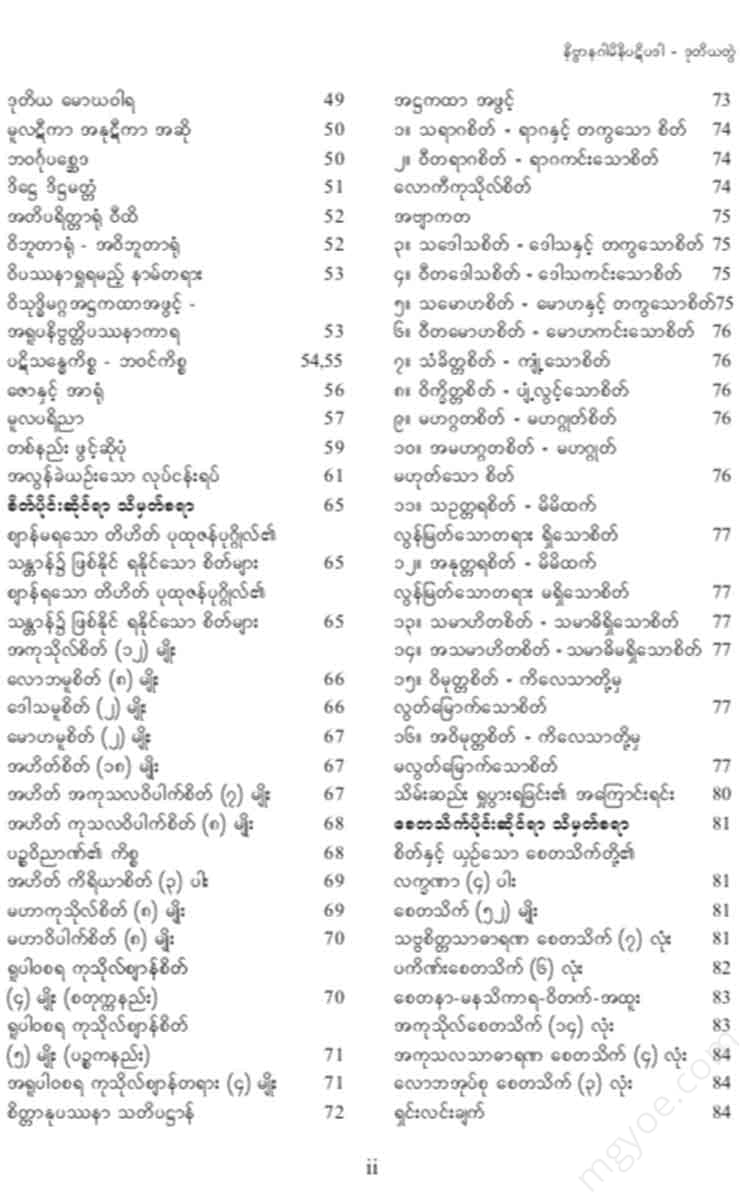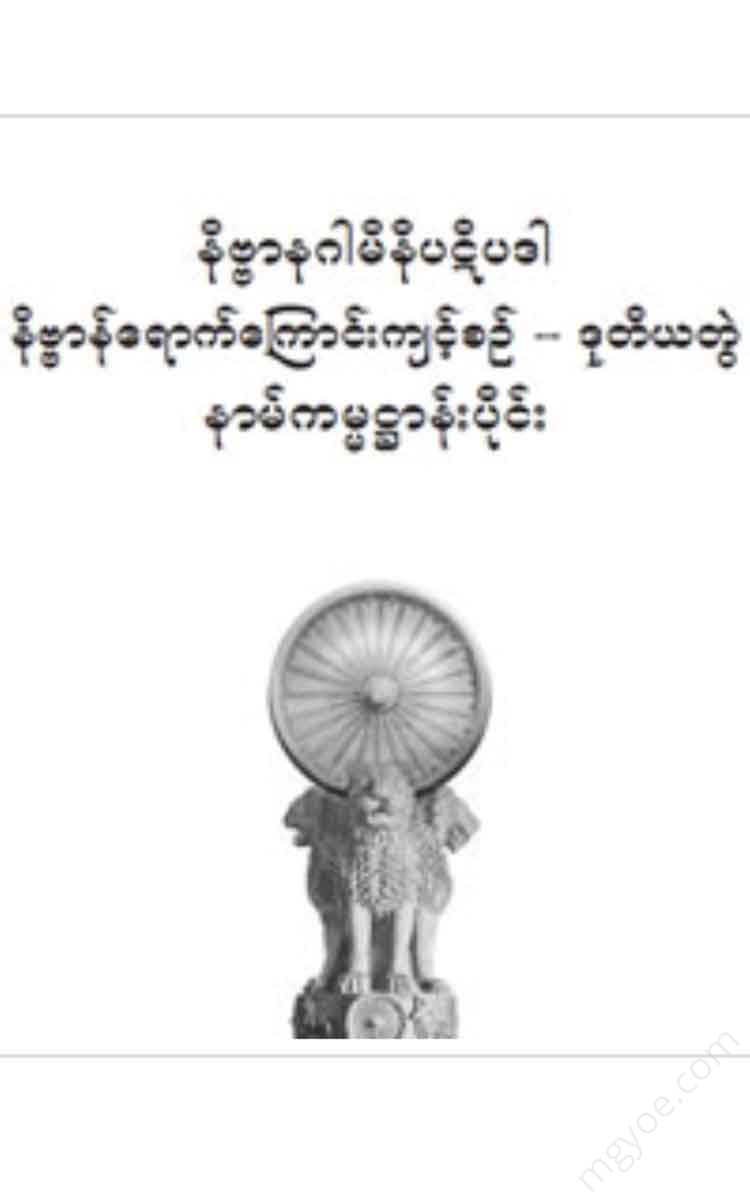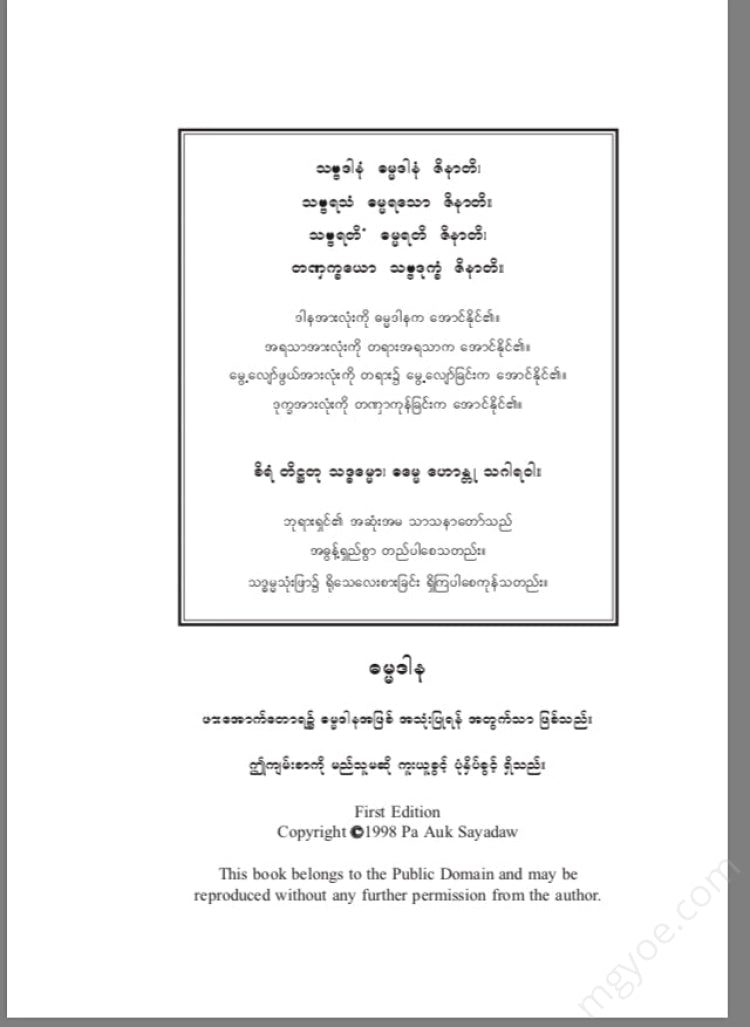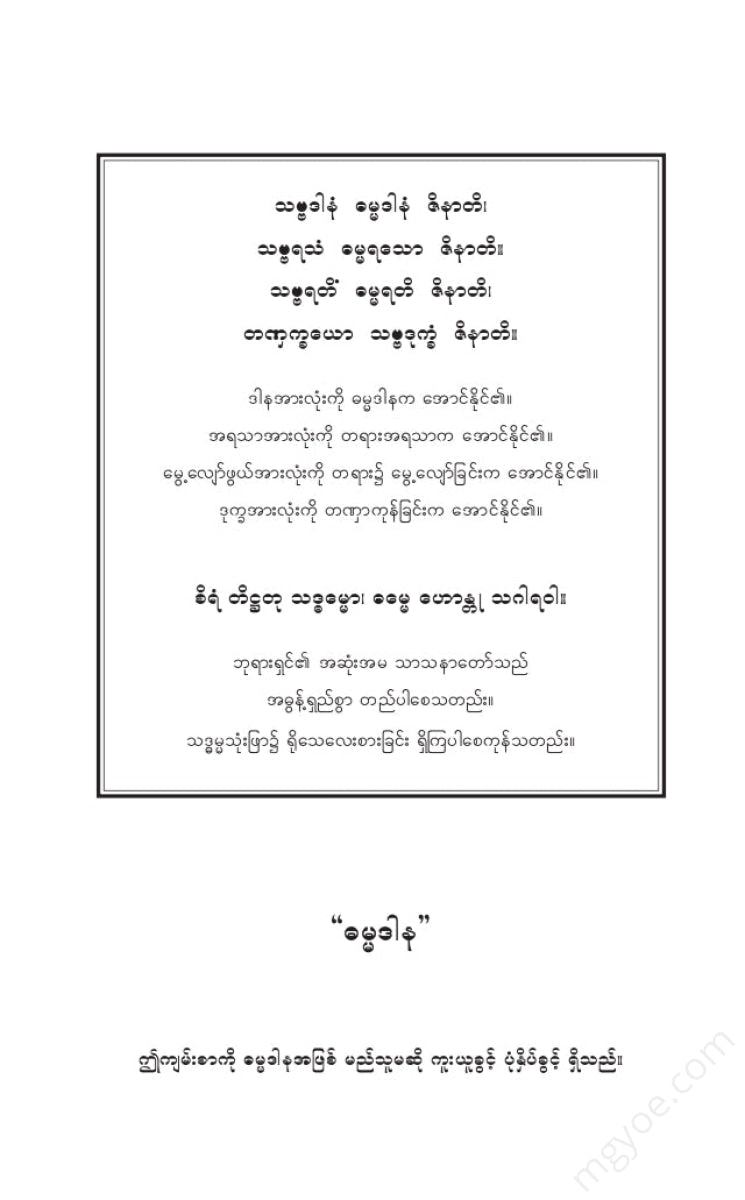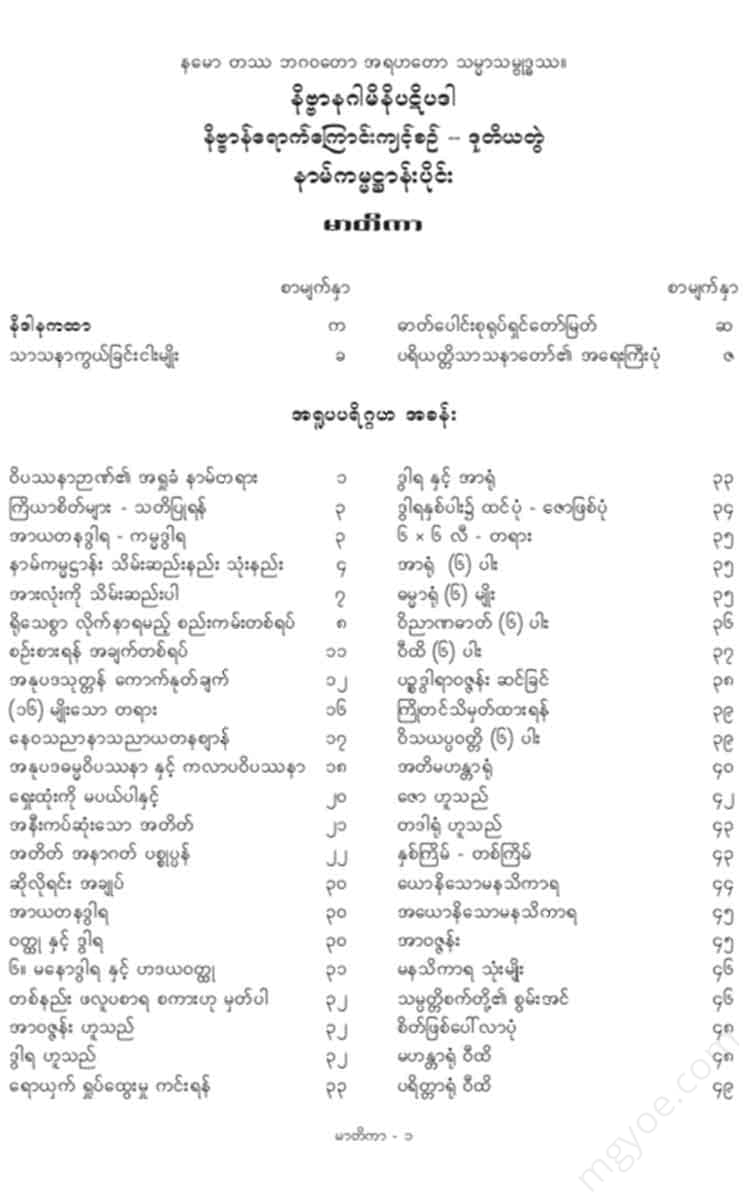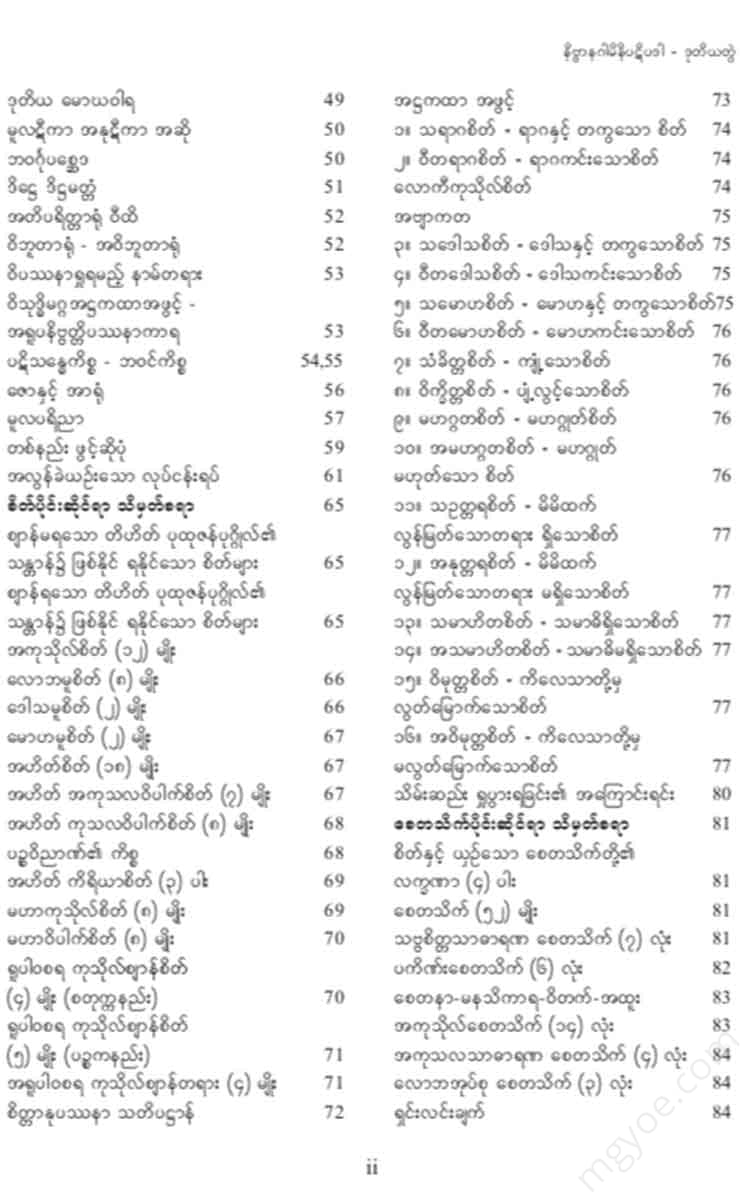Other Websites
Venerable Fapa Aok Tora Sayadaw - The Practice of Attaining Nibbana, Volume 2
Venerable Fapa Aok Tora Sayadaw - The Practice of Attaining Nibbana, Volume 2
Couldn't load pickup availability
This is the Dhamma, O bhikkhus, which is the essence of the Dhamma. This is the Dhamma, O bhikkhus, which is the essence of
If, bhikkhus, the Dhamma is “unrighteous,” then, bhikkhus, it is the cause of many,
If, bhikkhus, there is a great deal of wrongdoing
Now, monks, the Dhamma is the Dhamma.
Monks... those monks who proclaim wrongdoing as right. Monks... those monks act to the detriment of many, to the detriment of many, to the detriment of many, to the detriment of devas and humans, to their suffering. Monks... those monks also cause much unwholesomeness; those monks also cause this Dhamma to disappear. (An, 1, 18.)
Monks... those monks who show the Dhamma to be wrong. Monks... those monks act to the detriment of many, to the detriment of many, to the detriment of many, to the detriment of devas and humans, to their suffering. Monks... those monks also cause much unwholesomeness; those monks also cause this Dhamma to disappear. (An, 1, 18-19.)
Monks... those monks who show that wrongdoing is wrongdoing. Monks... those monks act for the benefit of many, for the happiness of many, for the benefit of gods and men, for the happiness of others. Monks... those monks also produce much wholesome action, those monks also establish this Dhamma. (An, 1, 19.)//
Monks... Those monks who manifest the Dhamma as the Dhamma, monks... those monks practice for the benefit of many, for the happiness of many, for the benefit of gods and men, for the happiness of others. Monks... those monks also produce much wholesome dharmas, those monks also establish this Dhamma. (An, 1, 19.)
Five types of religious persecution
Te seimam saddhammam antaradhapaneti - Those monks will cause this Dhamma to disappear. (An, 18-19.) In connection with the sermon, the five types of disappearance of Dhamma are explained as follows in the Anguttara Atthakatha (An, 1, 67-72.).
The religion of God is -
1. Adhigamasa
2. The religion of Patipatti
3. The religion of self-sacrifice
4. Sexuality
5. Chemical religion - yes
There are five types of this. The disappearance of the Dharma is also:
1. Adhigamā antaradhana. The concealment of the Adhigamā saṃsana.
2. The innermost essence of the Dharma, the essence of the Dharma,
3. Pariyatti antaradhana = the protection of the Pariyatti Sasana,
4. The hidden nature of the League of Nations
5. The danger of chemical warfare, the protection of chemical religion -
In this way, there are five types of religious practices.
How to avoid the practice of adhigamāsa
Of these five, in the Buddha's teaching, there are four paths, four fruits, four factors of origin, three knowledges, and six transcendental consciousnesses - these are the things that noble people should attain and attain - and they are called "adhikama". When they decline and disappear, they decline and disappear in order, starting with the four factors of origin. Only within (1000) years after the Buddha's passing away were noble people able to produce the factors of origin. In the period after that one thousand years, they were able to produce only the six factors of origin. In the period after that, they were not able to produce even the six factors of origin, but they were able to produce only the three knowledges. Again, if time passes and the three faculties are not able to be created, only the arahants of the blissful insight, whose essence of meditation has dried up, can arise. In this way, gradually, time passes and the arahants of the future, the arahants of the Sakadaga, and the sotapaññā can arise. As long as those noble ones remain in the world, the Buddha's great adhikama-sana will not disappear. However, when the last noble one, the sotapaññā, has passed away, the great adhikama-sana that the Buddha had not mentioned will disappear. This is the adhikama-antaradhāna = the disappearance of the adhikama-sana. (A, 8, 1, 67.)
The secret of the Patipatti religion
After the teachings, they were unable to make efforts to achieve the results of meditation, insight, and the path of enlightenment, but they were only able to maintain and practice pure morality. They were only able to maintain and practice the four precepts. Then, gradually, after a long period of time, when they returned to their former state,
“The path of the path is the path of the path, the
"Let us practice and maintain the precepts perfectly, and let us also practice the meditation called the main meditation, the samaha vipassana, but we will not be able to realize the noble path and the noble fruition. The insight into the noble path and the noble fruition, the noble fruition, is no longer possible at this present time." -
Thus, the monks, having become more and more lazy in the practice of meditation, have become less and less inclined to criticize one another, less and less inclined to forbid one another, and less and less inclined to consider the rules of conduct and conduct. From then on, they first began to violate the minor and major precepts. Then, gradually, as time passed and they became more and more degenerate, they committed the sins of the mind and the body. Then, they committed the sins of the Sangha and the Sangha. Only the four sins remained for the monks to practice. Even if the number of monks who have preserved the four precepts of the Buddha's Dharma is known, the Buddha's Dharma of the Path of the Buddha is not yet hidden. The last monk in the Dharma who had preserved the four precepts of the Buddha's Dharma and was practicing the precepts, because of the destruction of the precepts of the Path of the Buddha and the end of his life = his passing away, the Dharma of the Buddha is hidden. In this way, when there is no monk left who has preserved the four precepts of the Buddha, the Dharma of the Buddha is hidden.
(An, VIII, 1, 67-68.)
The secret of the religion of Pariyatti
As long as the Pali Canon and the Atthakatha exist, the entire Pali Canon will be established. When the time comes to a period of gradual decline, the people of the country will no longer observe the Dhamma, and the rain will not fall properly. Due to the irregular rain, the crops will not bloom fully and will decline. At that time, the people will be unable to donate the four items to the monks due to the shortage of food and clothing. The monks will be lacking the four items, and they will not be able to support their disciples and monks with the four items. At that time, when the decline is gradual, the learning of the monks and monks will decline. The meaning of the Pali Canon - They will no longer be able to carry the Atthakatha, and there will be no more learning from the teacher. Only through the power of the Pali can they carry the Pali text alone. Only through the power of the Pali text alone can they learn the Pali text alone.
Then, as it gradually declined, they became unable to learn and retain the entire Pali canon. Then, they could not understand the difficult texts, so they did not learn the Abhidhamma Pitaka. Therefore, the Abhidhamma Pitaka would disappear first. In the Abhidhamma (7) canons, the Pathāṇa will disappear first. Then, as usual, the Yamaika, Kathāsavāya , Puggalāya , Kāsamāka , Vibīṇa , and Dhammasangāṇi will disappear.
When the Abhidhamma Pitaka is abolished, the Sutta Pitaka will be abolished. In the Sutta Pitaka, the Anguttara Nikaya will be abolished first. Then the Samyutta Nikaya (5 books), the Mizzima Nikaya (3 books) , and the Digha Nikaya (3 books) will be abolished in that order. In this way, when the Digha Nikaya is abolished, the Sutta Pitaka will be abolished.
Only the Vinaya Pitaka and the Jātaka Discourse will be carried. Only good monks who love the virtue will carry the Vinaya Pitaka. Those monks who desire a lot of profit, thinking, "Even if they preach and teach the Suttas, there will be no one who remembers them well and practices them well," will carry only the Jatakas. Then, there will be no one who can preach all the Jatakas and no audience to listen to them, and the Jatakas will gradually disappear. When the Jatakas disappear, only the Vinaya Pitaka will be carried. When the time gradually passes, the Vinaya Pitaka will also disappear.
Finally, the rulers of the country ordered a thousand bundles of silver to be placed on top of a rock and circulated around the city three times, announcing, "If anyone can recite even one verse that the Buddha has spoken, I will give him a thousand silver coins." But no one would take the bundles of silver, and when the time came to return them to the royal treasury, the Buddha's great teachings were completely lost. (An, X, 1, 68-69.)
How to hide sexual intercourse
After the passing of the Great Teaching of the Pariyatti, the way the monks wore their robes, held their bowls, walked, and looked at them no longer had any reverence. They would also dye their robes only ivory or yellow. Then, after a long time, they would no longer dye their robes yellow, but would wear white linen with a Kappabindu or a waist band as people wear. (It is said that the custom of the Yonakata people to wear white clothes is a remnant of the custom of the monks who died after the teaching of the Buddha Kassapa.) Then, they would no longer wear even the white linen robes, but would simply wear a small piece of the robe on their hands, around their necks , or in their hair, as a token of their status as monks. Furthermore, they will earn their living by taking children and wives, trading, and farming. It was with this kind of false monkhood in mind that the Buddha spoke as follows.
The living being, the future, the family
(Matthew 3:299.)
Ananda ... Indeed, in the future, there will arise those who are unscrupulous, who have the rank of monk, who have attained the rank of monk, and who are unscrupulous, and who give alms to those who have no virtue, referring to the Sangha. Ananda ... Even in such a case, I say that the merit of almsgiving is incalculable and incomparable. Ananda, I do not by any means say that almsgiving is more beneficial than almsgiving.
(Ma, 3, 299. Dakshina Vibhaga Sutta.)
Eventually, the monks will consider even the robes as a useless and useless activity to expand and discard them. Then the sex religion will be hidden.
(An, VIII, 1, 69-70.)
How to hide the chemical religion
Know how the great Dhamma Dhamma is hidden. There are three types of Parinibbana: Parinibbana of defilements, Parinibbana of the body, and Parinibbana of the chemical elements.
The cessation of defilements - The cessation of defilements of the Buddha Gautama occurred on the day of the month of Kason in the Mahasakra (103) of the Maha Era at the Mahabodhi Temple. (The exact time and place of the cessation of defilements was known. This cessation of defilements is also called the cessation of defilements. Although all defilements have been eliminated, the five aggregates of defilements, both wholesome and unwholesome, which are called abyakata, remain and are not yet eliminated, so it is called the cessation of defilements.)
Sandapārinibbāna - The final cessation of the five aggregates, or the remaining aggregates, is called khandapārinibbāna. This khandapārinibbāna occurred when the Buddha passed away in the garden of the Mallas in Kusinārāna. This khandapārinibbāna is also called anupādisesānibbāna. It is the complete cessation of the five aggregates through the cessation of the five aggregates without any regret.
Chemical Parinibbana - In performing such chemical parinibbana, for the benefit of people -
"I, the Buddha, will not be allowed to remain in the human world for a long time before I pass away. My Buddha's teachings have not yet spread throughout all the human worlds and regions. Therefore, even if I, the Buddha, have passed away and taken even a mustard seed's worth of relics, all the people who have built pagodas in their respective places and worshipped and cared for me will have a place to rest in the heavens and on earth."
In this way, he intended for his relics to remain in pieces, not to remain as one solid piece, like a gold nugget.
1. Four (4) tusks ,
2. Collarbone (2 )
3. Nafuthin Kyitaw (1) -
These (7) elements remain in their original state. They are not broken. The remaining elements are broken into pieces. There -
1. The smallest of the elements is about the size of a mustard seed. It is the color of a jasmine flower.
2. Medium-sized elements are about the size of a grain of rice with a split in the middle. They are very pure, clean, and shiny, like pearls.
3. The largest of the divine relics is about the size of a pea split in the middle, and its color is like the color of gold.
(This, VIII, 2, 196.)
All of these above-mentioned relics are also called “immortal” relics because they cannot be broken down or destroyed again.
In this way, when he passed away, he left behind the "Asambinna" relics that were not broken or damaged for the benefit of people. These relics exist because of the Buddha's intention for people to make offerings to them. After a long period of time, people will spend their time in the pursuit of material wealth and will lose their wisdom and will no longer pay homage to his relics. At that time, all the relics in the human, divine, naga, and brahmin realms will go to the Great Bodhi Tree.
The Great Movie
All the elements will gather together in the Great Bodhi Tree and take the form of the Buddha and will stand in the Bodhi Tree. That combined Buddha image will be filled with (32) major signs of the noble men and (80) minor signs, and will be adorned with the radiance of the Vyāma Pāpa, the blazing yellow light, and the radiance of the Vyāma Pāpa. Furthermore, it will display the power of the water and fire.
At that time, there will be no human beings who have arrived there. All the devas and brahmas who exist in ten thousand universes will gather and lament, "Today , the Buddha, who was endowed with ten qualities and ten wisdom, has passed away. From this day on, from this time on, the world will be in complete darkness." Then, from within the aggregate of elements, the fire element will rise, and all the elements will be burned up and consumed without a trace.
The essence of the body, from the perspective of the Supreme Truth, is simply the sum of the aggregates of the physical bodies. The eight-fold form of the body is the result of the energy called the element of the body, which is created successively. In each of these elements, the energy contained in each element becomes extremely intense, burning up all the material bodies of the body to the point of being completely destroyed.
The flame that arises from the great composite body will rise to the Brahma realm, and even if there is a remnant of the body the size of a mustard seed, it will remain as a single flame. When all the bodies of the body are consumed, the flame will cease and pass away. Having manifested such great majesty, the bodies of the body will disappear and pass away.
At that time, all the devas and brahmins from all over the world, gathered together in unison, made offerings with incense, flowers, musical instruments, etc., just as they had done on the day of the passing away of the True Buddha. They circled around the Buddha three times, paying homage and paying homage.
In the future, the Buddha will be the one who
The Buddha, whose glory shines brightly... If you wish to have the opportunity to see the True Buddha who will be revealed in the future,
Having thus prayed, they returned to their respective celestial realms, the Brahma realms.
This is the secret of the chemical religion. (An, Htt, 1, 70-71.)
Namo Tassa Bhagavad Gita Arahant Gita Sammasambuddha.
Monogamy - Volume 2
Spiritual meditation
Introduction
Cover letter
Now, monks, the Dhamma is a source of unrighteousness, and
If, bhikkhus, the Dhamma is “unrighteous,” then, bhikkhus, it is a state of being that is not right,
"Therefore, monks, there is no wrongdoing,
Now, bhikkhus, the Dhamma is the Dhamma
Monks... Those monks who present unrighteousness as right, monks... those monks act to the detriment of many, to the detriment of many, to the detriment of many, to the detriment of devas and humans, to their suffering. Monks... those monks also cause much unwholesomeness, those monks also cause this Dhamma to disappear. (An-1-18.)
Monks... Those monks who declare the Dhamma to be wrong, monks... those monks act to the detriment of many, to the detriment of many, to the detriment of many, to the detriment of devas and humans, to their suffering. Monks... those monks also cause much unwholesomeness; those monks also cause this Dhamma to disappear. (An-1-18-19)
Monks... those monks who show that wrongdoing is wrongdoing, monks... those monks act for the benefit of many, for the happiness of many, for the benefit of gods and men, for the happiness of others. Monks... those monks also produce much wholesome action, those monks also establish this Dhamma. (An-1-19.)
Monks... Those monks who declare the Dhamma to be wrong, monks... those monks act to the detriment of many, to the detriment of many, to the detriment of many, to the detriment of devas and humans, to their suffering. Monks... those monks also cause much unwholesomeness; those monks also cause this Dhamma to disappear. (An-1-18-19)
Monks... those monks who show that wrongdoing is wrongdoing, monks... those monks act for the benefit of many, for the happiness of many, for the benefit of gods and men, for the happiness of others. Monks... those monks also produce much wholesome action, those monks also establish this Dhamma. (An-1-19.)
